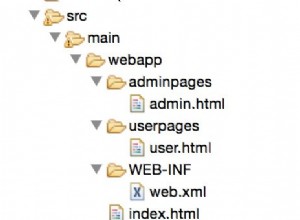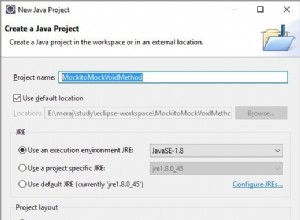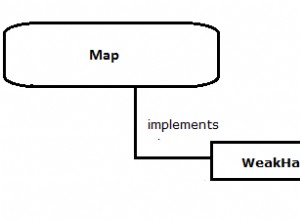Sådan planlægger du meddelelser i Android
IKKE TIL BRUG I OREO+ (rediger)
Svarene ovenfor er gode - men tag ikke hensyn til brugerens potentiale til at genstarte enheden (hvilket rydder PendingIntents planlagte af AlarmManager).
Du skal oprette en WakefulBroadcastReceiver, som vil indeholde en AlarmManager for at planlægge levering af en PendingIntent. Når WakefulBroadcastReceiver håndterer hensigten - send din notifikation og signaler til WakefulBroadcastReceiver at fuldføre.
WakefulBroadcastReceiver
/**
* When the alarm fires, this WakefulBroadcastReceiver receives the broadcast Intent
* and then posts the notification.
*/
public class WakefulReceiver extends WakefulBroadcastReceiver {
// provides access to the system alarm services.
private AlarmManager mAlarmManager;
public void onReceive(Context context, Intent intent) {
//// TODO: post notification
WakefulReceiver.completeWakefulIntent(intent);
}
/**
* Sets the next alarm to run. When the alarm fires,
* the app broadcasts an Intent to this WakefulBroadcastReceiver.
* @param context the context of the app's Activity.
*/
public void setAlarm(Context context) {
mAlarmManager = (AlarmManager) context.getSystemService(Context.ALARM_SERVICE);
Intent intent = new Intent(context, WakefulReceiver.class);
PendingIntent alarmIntent = PendingIntent.getBroadcast(context, 0, intent, 0);
Calendar calendar = Calendar.getInstance();
calendar.setTimeInMillis(System.currentTimeMillis());
//// TODO: use calendar.add(Calendar.SECOND,MINUTE,HOUR, int);
//calendar.add(Calendar.SECOND, 10);
//ALWAYS recompute the calendar after using add, set, roll
Date date = calendar.getTime();
mAlarmManager.setExact(AlarmManager.RTC_WAKEUP, date.getTime(), alarmIntent);
// Enable {@code BootReceiver} to automatically restart when the
// device is rebooted.
//// TODO: you may need to reference the context by ApplicationActivity.class
ComponentName receiver = new ComponentName(context, BootReceiver.class);
PackageManager pm = context.getPackageManager();
pm.setComponentEnabledSetting(receiver, PackageManager.COMPONENT_ENABLED_STATE_ENABLED,
PackageManager.DONT_KILL_APP);
}
/**
* Cancels the next alarm from running. Removes any intents set by this
* WakefulBroadcastReceiver.
* @param context the context of the app's Activity
*/
public void cancelAlarm(Context context) {
Log.d("WakefulAlarmReceiver", "{cancelAlarm}");
mAlarmManager = (AlarmManager) context.getSystemService(Context.ALARM_SERVICE);
Intent intent = new Intent(context, WakefulReceiver.class);
PendingIntent alarmIntent = PendingIntent.getBroadcast(context, 0, intent, 0);
mAlarmManager.cancel(alarmIntent);
// Disable {@code BootReceiver} so that it doesn't automatically restart when the device is rebooted.
//// TODO: you may need to reference the context by ApplicationActivity.class
ComponentName receiver = new ComponentName(context, BootReceiver.class);
PackageManager pm = context.getPackageManager();
pm.setComponentEnabledSetting(receiver, PackageManager.COMPONENT_ENABLED_STATE_DISABLED,
PackageManager.DONT_KILL_APP);
}
BootReceiver
public class BootReceiver extends BroadcastReceiver {
@Override
public void onReceive(Context context, Intent intent) {
if (intent.getAction().equals(Intent.ACTION_BOOT_COMPLETED)) {
context = ApplicationActivity.class;
AlarmManager alarmManager = (AlarmManager) context.getSystemService(Context.ALARM_SERVICE);
Intent intent = new Intent(context, WakefulReceiver.class);
PendingIntent alarmIntent = PendingIntent.getBroadcast(context, 0, intent, 0);
Calendar calendar = Calendar.getInstance();
calendar.setTimeInMillis(System.currentTimeMillis());
//// TODO: use calendar.add(Calendar.SECOND,MINUTE,HOUR, int);
//calendar.add(Calendar.SECOND, 10);
//ALWAYS recompute the calendar after using add, set, roll
Date date = calendar.getTime();
alarmManager.setExact(AlarmManager.RTC_WAKEUP, date.getTime(), alarmIntent);
}
}
}
AndroidManifest.xml
<receiver android:name=".WakefulReceiver"/>
<receiver android:name=".BootReceiver"
android:enabled="false">
<intent-filter>
<action android:name="android.intent.action.BOOT_COMPLETED"/>
</intent-filter>
</receiver>
Du skal bruge PendingIntent og BroadCastReceiver for dette -
public void scheduleNotification(Context context, long delay, int notificationId) {//delay is after how much time(in millis) from current time you want to schedule the notification
NotificationCompat.Builder builder = new NotificationCompat.Builder(context)
.setContentTitle(context.getString(R.string.title))
.setContentText(context.getString(R.string.content))
.setAutoCancel(true)
.setSmallIcon(R.drawable.app_icon)
.setLargeIcon(((BitmapDrawable) context.getResources().getDrawable(R.drawable.app_icon)).getBitmap())
.setSound(RingtoneManager.getDefaultUri(RingtoneManager.TYPE_NOTIFICATION));
Intent intent = new Intent(context, YourActivity.class);
PendingIntent activity = PendingIntent.getActivity(context, notificationId, intent, PendingIntent.FLAG_CANCEL_CURRENT);
builder.setContentIntent(activity);
Notification notification = builder.build();
Intent notificationIntent = new Intent(context, MyNotificationPublisher.class);
notificationIntent.putExtra(MyNotificationPublisher.NOTIFICATION_ID, notificationId);
notificationIntent.putExtra(MyNotificationPublisher.NOTIFICATION, notification);
PendingIntent pendingIntent = PendingIntent.getBroadcast(context, notificationId, notificationIntent, PendingIntent.FLAG_CANCEL_CURRENT);
long futureInMillis = SystemClock.elapsedRealtime() + delay;
AlarmManager alarmManager = (AlarmManager) context.getSystemService(Context.ALARM_SERVICE);
alarmManager.set(AlarmManager.ELAPSED_REALTIME_WAKEUP, futureInMillis, pendingIntent);
}
Du skal også vise besked i din modtagerklasse -
public class MyNotificationPublisher extends BroadcastReceiver {
public static String NOTIFICATION_ID = "notification_id";
public static String NOTIFICATION = "notification";
@Override
public void onReceive(final Context context, Intent intent) {
NotificationManager notificationManager = (NotificationManager) context.getSystemService(Context.NOTIFICATION_SERVICE);
Notification notification = intent.getParcelableExtra(NOTIFICATION);
int notificationId = intent.getIntExtra(NOTIFICATION_ID, 0);
notificationManager.notify(notificationId, notification);
}
}
Ring endelig til scheduleNotification() med passende argumenter, og du er god til at gå!



